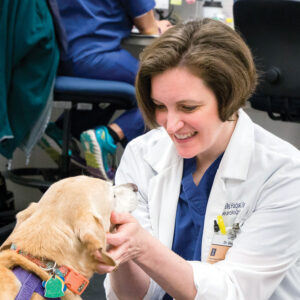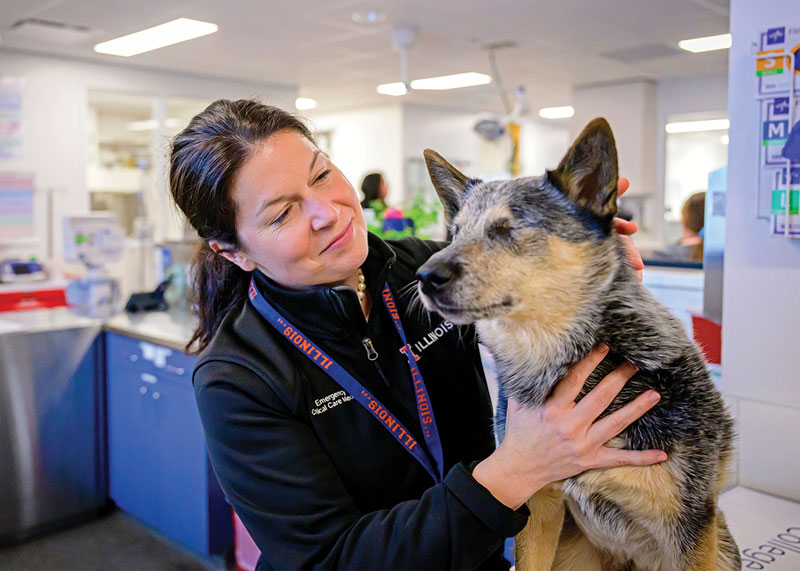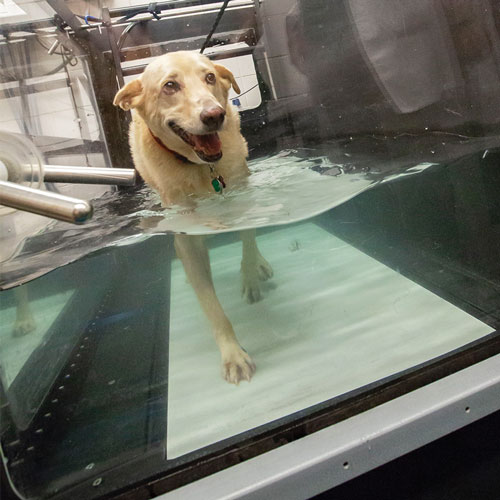
Intervertebral disc disease is one of the most common neurologic conditions seen in dogs that we treat as veterinarians. Extrusions of degenerative nucleus pulposus is a common cause of acute immobility in our patients. Therefore, understanding how to diagnose and manage this disease while providing clear client communications with regards to expectations and management will be helpful to improve outcomes in patients.
About one year ago, the American College of Veterinary Internal Medicine (ACVIM) consensus statement on the diagnosis and management of acute thoracolumbar intervertebral disc extrusion was published in the Journal of Veterinary Internal Medicine (JVIM). The ACVIM consensus statements are published by each of the specialty colleges under the umbrella of ACVIM (Cardiology, Large Animal Internal Medicine, Neurology, Nutrition, Oncology, and Small Animal Internal Medicine). (Side note, the Nutrition specialty joined ACVIM in October 2021.)
The statements are a way to provide the most comprehensive and up to date information about a particular disease process. These recommendations are initially compiled by a panel of experts in the particular disease based on a review of the evidence. Then, that panel presents the information to all diplomate members of the ACVIM to solicit input, which can be incorporated into the statement. These statements are then submitted to JVIM for edits prior to publication. All articles published in JVIM are open access, meaning you (and your clients) will have this great information at your fingertips!
Referring veterinarians: Feel free to contact the neurology & neurosurgery service if you have any questions related to neurologic diseases in general or to discuss a specific neurologic patient. Our doctors are available by telephone through the referral coordinator line (217-333-5311) or via email at vthneurology@vetmed.illinois.edu.
Below are several helpful facts and tips to consider when you are managing patients with acute thoracolumbar intervertebral disc extrusions (TL-IVDE). If you would like to read more specific information, here is the link to the consensus statement: https://doi.org/10.1111/jvim.16480. Note: All of the statements below are quoted directly from this study.
The author panel of the consensus statement assigned statements based on level of available evidence in the veterinary literature. High levels of evidence were defined as being supported by multiple randomized controlled clinical trials. [At this time, there is no information about IVDE in this high level category]. Moderate levels of evidence, were collected from multiple retrospective studies, controlled trials, or a single placebo controlled trials. Low levels of evidence were obtained from isolated or smaller retrospective studies and therefore produced less reliable statements.
Moderate to High Levels of Evidence
The statement below is supported by moderate to high levels of evidence:
- “In paraplegic deep pain negative (DPN) dogs, success with medical management is largely poor with an increase in the frequency of PMM. Surgical management is recommended.”
Moderate Levels of Evidence
The facts below are based on moderate levels of evidence:
- “Magnetic resonance imaging, CT, CT-myelography or myelography are reasonable modalities for diagnosing TL-IVDE. When extruded material is mineralized, especially in young to middle-aged adult, chondrodystrophic dogs, CT is sensitive in diagnosis and treatment planning. It therefore can be recommended as a first-line advanced imaging modality when acute TL-IVDE is suspected, with a low likelihood of missing a compressive surgical lesion and the added benefit of shorter scan time and lower cost (compared to MRI). Magnetic resonance imaging provides definition of intramedullary lesions which can inform surgical approach and prognostication for dogs with severe injuries and has superior ability to make diagnoses other than IVDE. When considering cases outside this typical clinical presentation, there is evidence to support the highest diagnostic sensitivity for high field MRI and higher risk of adverse events with myelography or CT-myelography.”
- “Magnetic resonance imaging (over CT or myelography) can provide prognostic information in paraplegic dogs, especially paraplegic DPN dogs.”
- “Ambulatory dogs can be managed successfully medically; however, consideration should be given to risk of recurrence. Surgical management might be considered in a young, active dog with multiple mineralized discs, particularly with recurrent events. Surgical decompression can be considered when neurologic signs are progressive, unimproved or pain is persistent despite appropriate medical management.”
- “Although non-ambulatory paraparetic or paraplegic deep pain-positive (DPP) dogs can be managed successfully medically, success rates, rate of recovery and chance of recurrence are more likely to be improved with surgery. Surgical management for these dogs is recommended.”
- “Corticosteroids are not recommended for routine use in medical management of the acute phase of presumptive TL-IVDE. In the chronic phase, a short course of anti-inflammatory doses of corticosteroids may be of benefit for some dogs.”
- “The pathogenesis of IVDE-induced SCI supports that surgical decompression ought to be performed as early as possible for dogs with substantial neurologic deficits. However, taken as a whole, the current literature does not generally support the use of a specific timeline for urgent surgical decompression, even for DPN dogs that are paraplegic at the time of presentation. Some evidence suggests that delayed decompression may result in a longer time to achieve postoperative ambulation, which requires further investigation. The influence of surgical timing on locomotor outcome should be considered independently of its influence on development of PMM.”
- “Surgical treatment should not be declined simply because the dog has been paralyzed for an extended period, because the literature documents that recovery of ambulation may occur for dogs that present with DPN status and have been paralyzed > 1 week before surgery.”
- “Fenestration of the herniated disc space at the time of surgical decompression is recommended to minimize risk of recurrence at the site of herniation.”
- “When used in combination with decompressive surgery for dogs that are paraplegic DPN at the time of presentation, DMSO might improve locomotor outcome. Routine administration of DMSO, although currently not recommended as standard adjunctive neuroprotective treatment for acute TL-IVDE, deserves further evaluation in a larger cohort.”
- “Paraplegic dogs cannot urinate voluntarily, whereas dogs with motor function and pain perception can. As voiding recovers, it is commonly incomplete for a period of weeks post-injury, resulting in urine retention. This complication places dogs at higher risk than usual for development of UTI. Dogs with severe injury, even if they recover pain perception and motor function, might have suboptimal continence.”
- “Bladder expression technique chosen should be tailored to the dog, the clinician and the technicians caring for the dog. Placement of an indwelling urinary catheter is an effective and low risk management method in the short term; however, duration of indwelling catheterization should be minimized whenever possible because of increased risk of UTI. As voluntary urination returns, the bladder should be palpated, or ultrasonography performed, to ensure adequate emptying has been achieved.”
- “Reasonable timing for postoperative rehabilitation in dogs consists of initiation within a 24-hour to 14-day window postoperatively and continuing for at least 2 to 6 weeks. However, it is possible that optimal timing might fall outside of this timeframe or might vary among patient subsets (e.g., based on severity of neurologic status).”
- “A combination of clinical findings can support a high level of concern for PMM and, when further coupled with imaging findings and longitudinal monitoring for specific changes in the neurologic examination and serum biomarkers, can be even more highly suggestive of the condition.”
Low to Moderate Levels of Evidence
The facts below are supported by low to moderate levels of evidence:
- “When dogs cannot be treated surgically, a medical treatment attempt is reasonable for all grades of injury severity unless there is clinical evidence of PMM.”
- “The use of NSAIDs for at least 5-7 days is recommended in dogs managed medically for TL-IVDE, provided there is no specific contraindication. Requirement for analgesia beyond this time period, despite appropriate activity restriction, should be considered as a possible indication for further investigation and potentially surgical management. The use of concurrent corticosteroids or multiple NSAID formulations in combination should be avoided.”
- “Percutaneous laser disc ablation (PLDA) appears to be safe and, based on a low-level of evidence in a large number of dogs, may limit recurrent disc extrusion.”
- “In dogs with incomplete injuries, rehabilitation performed postoperatively is safe but fails to demonstrate benefit on the rate or extent of recovery of walking compared to dogs receiving only basic exercises (e.g., PROM, assisted walking). Although these findings suggest that more intensive, tailored rehabilitation protocols are not needed for all dogs with incomplete injuries to achieve a successful outcome (i.e., independent, coordinated ambulation), available evidence does support inclusion of basic exercises as standard components of routine postoperative care in all dogs regardless of severity.”
Low Levels of Evidence
These statements are based on low levels of evidence:
- “Short-term hospitalization for 1-2 days should be considered in dogs with progressive signs managed medically, to monitor for deterioration in neurological status.”
- “A least 4 weeks of restricted activity is recommended, putatively to promote healing of the annulus fibrosus. This period should include confinement to a restricted area (crate ideally, or a small room without furniture) except for when performing rehabilitation exercises or outdoor toileting. There should be no off-leash walking, no jumping on or off furniture and no access to stairs during this time.”
- “Appropriate options for management of pain in dogs with TL-IVDE managed medically include an NSAID, gabapentin or pregabalin for neuropathic pain and potentially muscle relaxants such as diazepam or methocarbamol. For dogs with pain severe enough to merit treatment with opioids, hospitalization should be recommended until that pain is controlled adequately.”
- “Although there is a low level evidence to support the use of acupuncture as a component of medical management of TL-IVDE, this treatment option currently is not recommended as an alternative to surgical management. Despite limited evidence to support the use of physical rehabilitation in medically treated dogs, basic rehabilitation exercises are recommended as an additional treatment (e.g., passive range of motion exercises and massage), with an emphasis on restricted activity for at least 4 weeks, followed by increased levels of physical activity.”
- “Insufficient evidence exists to support a single surgical approach to fenestration over another, and surgical approach tends to be dictated by the decompressive procedure and surgeon experience. Creating a fenestration without subsequently curetting NP from the disc space does not lead to removal of disc material by an inflammatory response. Although power fenestration has been shown to improve yield over manual (blade) fenestration, complete fenestration is not achieved by any technique, and the relationship between increased NP removal and recurrence after fenestration has not been explored.”
- “Dogs can experience surgical site discomfort for up to 6 weeks after hemilaminectomy and a small percentage might develop chronic neuropathic pain. The need for prolonged treatment of pain is unclear, but veterinarians should evaluate dogs for pain at the time of first re-evaluation and advise owners to observe for signs of pain (e.g., vocalizing, reluctance to do certain activities, flinching when touched) for up to 6 weeks.”
- “Gastrointestinal mucosal lesions are common in dogs with IVDE, but often are subclinical. It is not known if these lesions are caused by the disease itself, the medications used or a combination of both. Life-threatening GI lesions have been reported in dogs treated with high doses of dexamethasone or with combinations of NSAIDs and glucocorticoids. If GI signs are present, NSAIDs or glucocorticoids should be discontinued. The use of opioids should be considered as a potential contributing factor to regurgitation.”
- “Although evidence is lacking to guide use of medications to relax the urethral sphincters in dogs with TL-IVDE, use of an alpha-adrenergic antagonist to relax the internal urethral sphincter with or without a centrally acting muscle relaxant such as diazepam to relax the external sphincter is recommended in dogs in which the bladder cannot be manually expressed easily. These drugs should be continued until voluntary urination has been re-established. Long-term use of these medications usually is not necessary in chronically paralyzed dogs.”
- “Antibiotics should not be used prophylactically to decrease the frequency of UTIs in dogs with TL-IVDE and it is important to establish a specific diagnosis of UTI versus clinically insignificant bacteriuria. The risk of UTI can be minimized by limiting duration of indwelling catheterization, monitoring voiding efficiency, and using medications to relax urethral sphincters as needed.“
- “The specific exercises and adjunctive modalities that should be included in an optimal postoperative rehabilitation regimen remain to be determined. At a minimum, a basic rehabilitation protocol can be recommended to include cryotherapy, PROM, massage, assisted standing and walking, which can be performed with no specialized equipment or training. Although more data are needed to evaluate precisely how such treatment protocols should be adapted over time, a stepwise approach with increasing intensity and incorporation of additional exercises can be tailored to the individual patient as neurologic status changes.”
- “Despite limited evidence, there is consensus agreement that confinement and activity restriction for a period of at least 4 weeks be recommended as a component of standard postoperative care for dogs with TL-IVDE. Note that activity restriction does not mean avoidance of rehabilitation exercises.”
- “Dogs with IVDE of the lumbar intumescence, that progress to paraplegic DPN status might be at higher risk for the development of PMM compared to those with lesions at other sites in the thoracic and lumbar spinal cord.”
- “Although French bulldogs appear to have a higher incidence of PMM, the study that reported breed-specific increased risk did not control for other factors that could have contributed to higher numbers of affected French bulldogs.”
- “Currently, there is not sufficient evidence to support the use of corticosteroids as a protective strategy against the development of PMM.”
By Devon Hague, DVM, DACVIM (Neurology)




